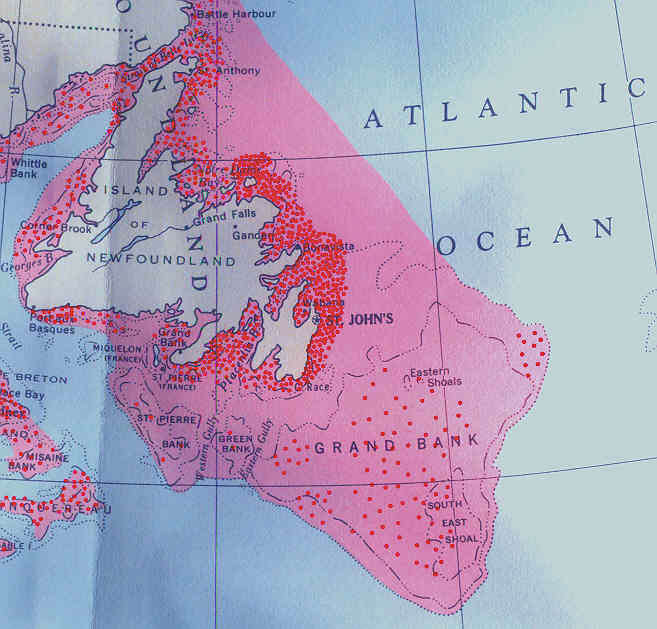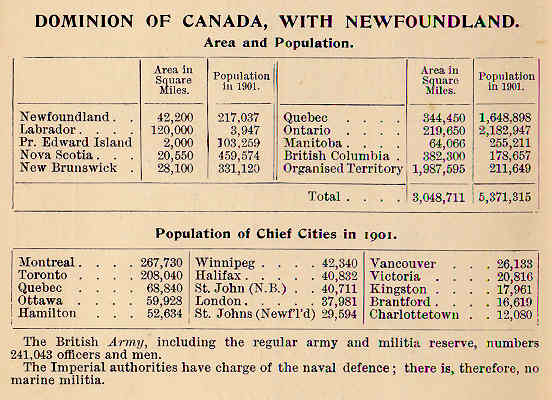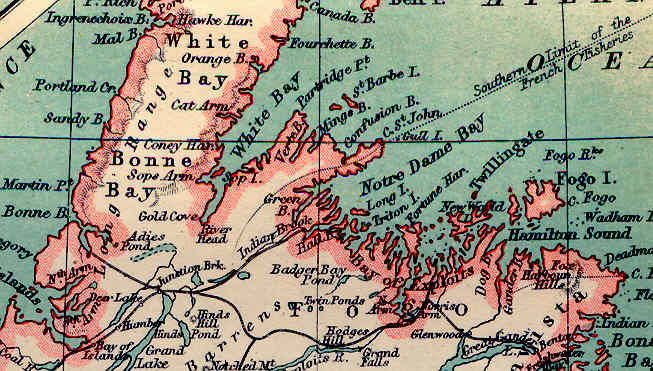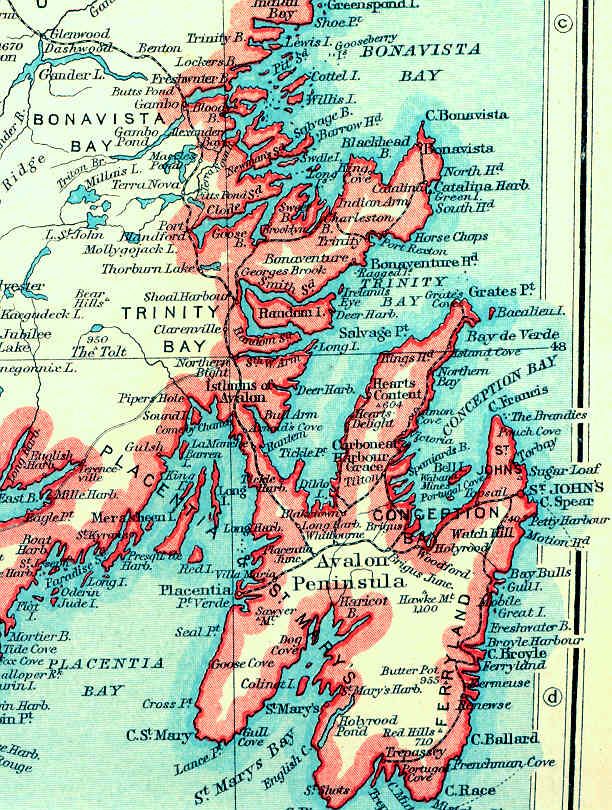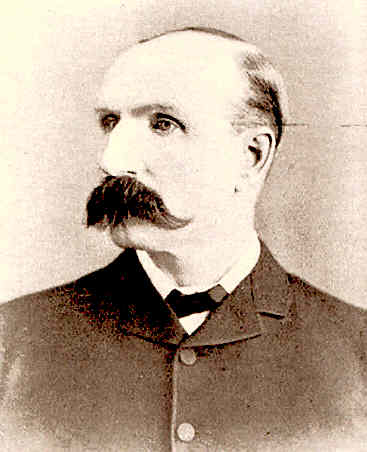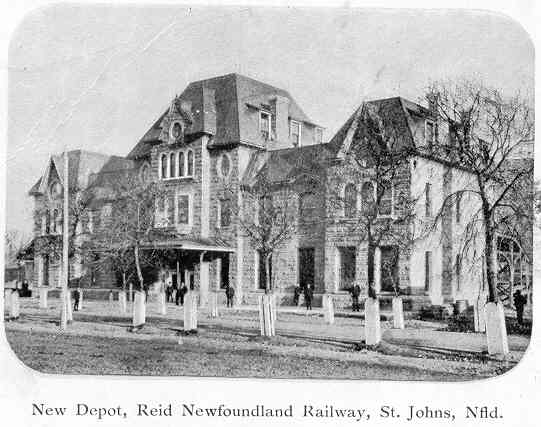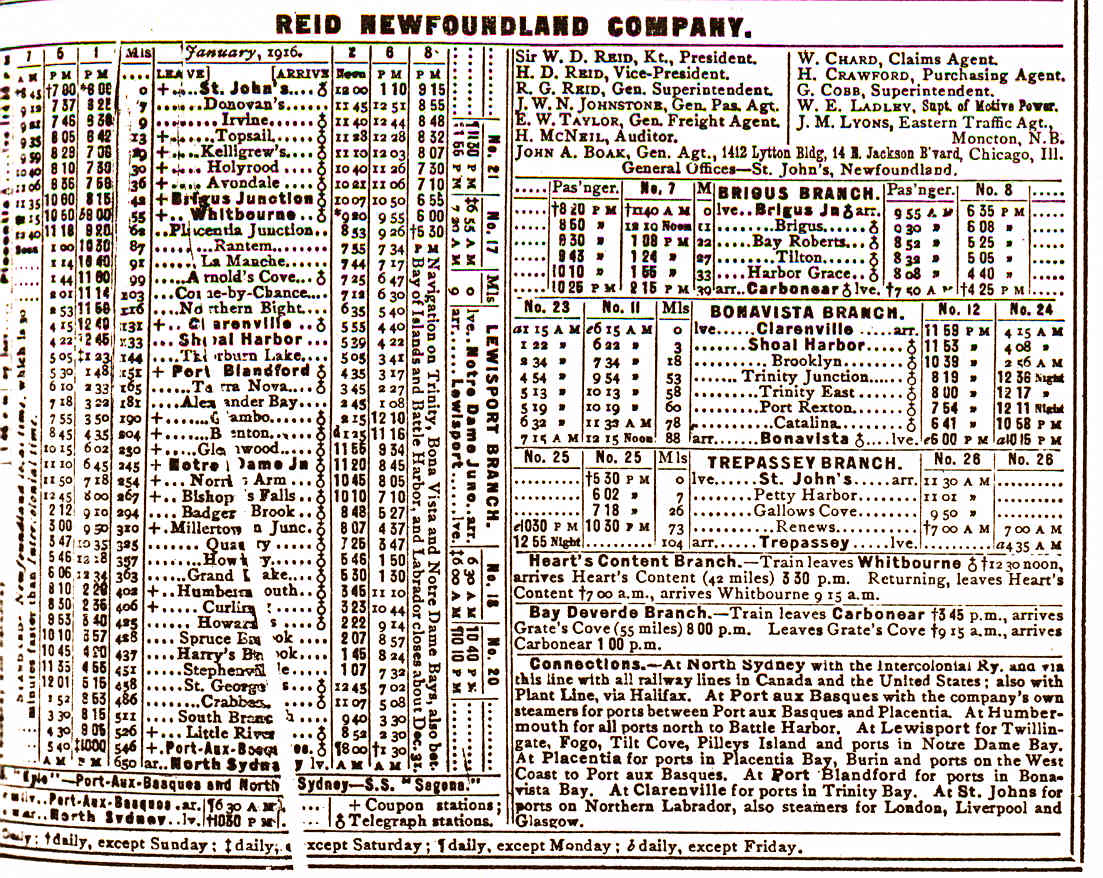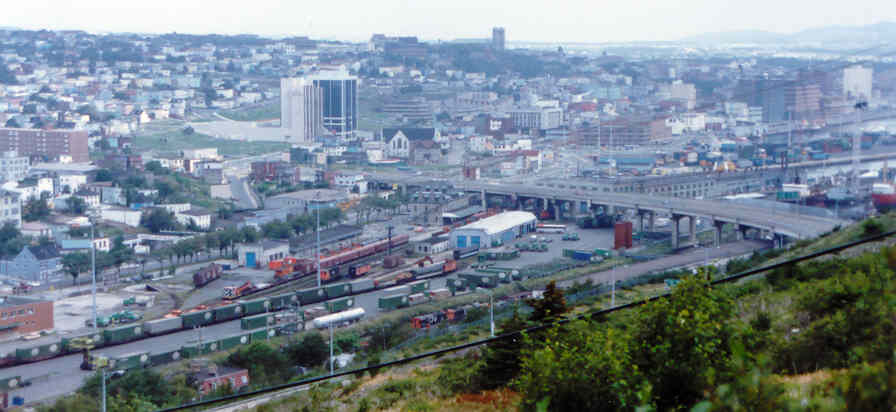Laying some track - William Whiteway
Into all the complexities of Newfoundland politics came William
Whiteway. He was born in Devon, England in 1828. His family had long
been involved in Newfoundland trade and he was sent over to apprentice
with a merchant in 1843. Later he became a lawyer. Throughout his political
career, his reach often exceeded his grasp, but he was tactful and often
tactically successful in getting what was required. Originally representing
the north-eastern constituency around Twillingate and Fogo (map coming
up), he first became premier as a member of the "establishment" Conservative
Party in 1878.
Whiteway thought if Newfoundland was ever to get away from
the ups and downs of the fishing industry, it had to diversify its
economy. The best way to do this was to develop what he assumed to
be the vast mineral and forest wealth in Newfoundland's interior. Travelling
from a remote constituency, he could see the benefit of pulling settlements
together with a railway. Everyone else in North America was doing it.
British colonial officials didn't want to financially support
Whiteway's railway, claiming it was a local project and of no use to
the British Empire. They were cool to the idea of locating the western
terminus on the French shore in case it inflamed British-French relations.
But they liked Whiteway's tone when he was at meetings with the French
in London - he seemed more open to compromise about the French Shore than
other Newfoundlanders.
Turning down a Canadian contractor, Whiteway pushed a railway
construction bid from a New York syndicate through the Newfoundland
legislature in 1880. The railway was to be a narrow gauge line from St.
John's to Hall's Bay on Notre Dame Bay.
Here's the map :
You can see Whiteway's original constituency
location of Twillingate and Fogo at the right.
This map also has two features I have found on no other from
this era, circa 1900 :
Hall's Bay on Notre Dame Bay (Hall B) ;
and the 1783 Treaty of Paris location of the eastern boundary
of the French Shore - dotted line, top right.
The French Shore ran counter-clockwise around the north and west shores
of the island from this point.
If you care: The railway branchlines to Bonne Bay and Halls
Bay were perhaps projected, but never built.
The actual route to Hall's
Bay was to be a direct northwest routing from St. John's - not a reversing
direction branchline as shown.
The Newfoundland Railway Company (NRC) of the New York syndicate
started building in 1881 - the same year as the new "CPR Syndicate"
in Canada. Bonds for the NRC were sold to investors in England to raise
the necessary capital.
In 1882, a little bit of change was suggested by the New York
syndicate :
- Make the line standard gauge.
- Take the railway across the island to be part of a "Steel of Empire"
idea which would connect with Canada via ferry - as Sandford Fleming
had promoted.
- Build a drydock in St. John's - a pet idea of Whiteway's
Symbolic of what was about to happen, the NRC syndicate was
using inadequate narrow gauge locomotives which were being discarded
by the PEI Railway. Built in England, they were appropriate for
cutting through fog, but snow was another matter.
In 1884, without the Newfoundland government's financial
support for the expanded west coast railway project, the NRC
filed for bankruptcy, defaulting on its bonds. The receiver for the
British bondholders appointed a former CPR foreman to complete the 86
miles of track partly laid and graded by the NRC.
The newly created Reform Party (Protestant politicians
and merchants) of Robert Thorburn defeated Conservative
Premier Whiteway in 1885 - the same year the CPR was completed. To get
needed support from Liberal members in a traditionally French
and Catholic area, a railway line was built down to Placentia (map below)
by the Reformers and opened in 1888. As always in our part
of the British Empire, a railway built directly by the government as a
public work was a catastrophe ... so many political supporters
to pay back ... and so much time and government money to do it.
If you can find St. John's, sneaking off the
map to the right, you can follow the earliest railway line.
It travels south-west through Whitbourne to Placentia.
The name is Bond ... Robert Bond
Born in 1857 in St. John's, and about 30 years William Whiteway's
junior, was Robert Bond. Thanks to the prudently invested assets of
his late English-born father, Bond never needed to work or become a
politician.
In 1874, his mother entered him into an agreement to become
a law clerk in William Whiteway's law office for five years. He never
became a lawyer. He travelled to Europe in 1880 and later spent ten
weeks camping on the inspiring west coast of Newfoundland in 1881. He
subsequently became a politician, winning the seat of Trinity Bay - just
north of the Avalon Peninsula on the map above - in 1882.
In 1888 with other supporters, Bond urged Whiteway to start
a new "Whiteway" Party ... taking over the political
place of the middle-of-the-road Liberal Party ... which was typical of
Whiteway's ability to draw support from both Protestants and Catholics.
Voters noted the failure of Premier Robert Thorburn's
Reform Party promise to conduct government affairs - such as
the Placentia railway line construction above - according to "sound business
practices" ... Whiteway was back in as premier in 1889, heading the
Liberal Party as they named their new pro-railway party.
Laying some more track - Robert Gillespie
Reid
With Whiteway the champion of railways back, care was taken
this time not to hire just any contractor, or to build the railway as
a department of the government. After a proper and thorough call for
tenders, Robert Gillespie Reid was selected to continue with Newfoundland's
railway.
Reid was born in 1842 in Scotland and apprenticed there as a
stone mason. After working in Australia and then Scotland again, he came
to Canada and did some of the stonework on the first Parliament Buildings
of Canada. Next, he began working as a bridge builder and made his name
in this field working first as the "outside man" for the railway construction
firm of Isbester and Reid.
The "inside man" was James Isbester as in Isbester's Landing
- the first name for the CPR's division point at Schreiber
, Ontario.
... perhaps you've heard of it.
Reid worked on bridges on the north shore of Lake Superior,
including in the Jackfish Bay area. He worked at a number of locations
in Canada and the US, building bridges for various railways. He also
constructed the Lachine Bridge near Montreal for the CPR's main line
to the Maritimes over the St. Lawrence River. Working with his eldest son
for the first time, he also laid the railway line which became the CPR
connection between Sudbury and Sault-Ste-Marie.
A postcard view of the Lachine Bridge,
upstream
from the Lachine Rapids, between Adirondack Jct. ; and LaSalle (on the
far north shore) .
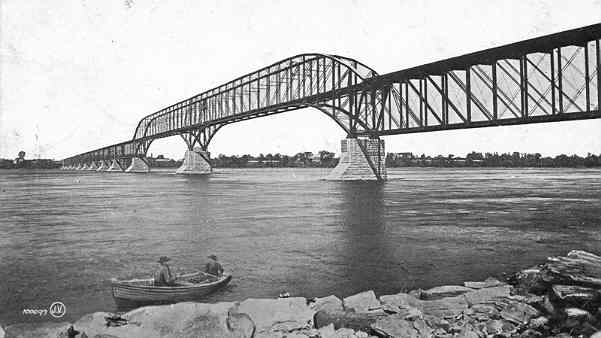
The contract with Reid was signed in 1890 ... Rail weighing 50
pounds per yard, rather than 35 pounds per yard, was to be used - these
are both light rails, but then this is narrow gauge. Bridges were to
be built of steel and masonry - i.e. no timber trestles. He had to put
up a $250,000 performance bond and the government could dictate changes
to some construction processes if they chose. Reid had 5 years to complete
262 miles of railway to Hall's Bay.
Reid was a wealthy man after all his years of work, but like
many others, railway building was probably in his blood. It seems likely
that the chance to build "his own coast to coast railway" sounded like
a satisfying way to cap off a long and successful career. He would also
be able to work with his three sons on the project.
Robert Gillespie Reid
Before olde tyme Newfoundland politics lunge, perhaps consider a
few points:
- Given the size and expense of most transportation systems, virtually
all are partially subsidized by the state.
- Governments - politicians - are often very involved
with a railway system's legislative and regulatory "rules of existence"
to keep constituents (voters and on-line industries) as happy as possible.
- Railway contractors in Canada often made money from building
railways, but operating a newly-built railway
through wilderness before settlement and on-line industry matured ...
lost money . Realistically, some type of operating
subsidy was required during the first years of the Newfoundland Railway's
operation.
- Capital - from investors - is mobile, sensitive and scarce
. Who would invest in a wilderness railway without a clear forecast
that revenue from moving people and things would soon be profitable
? The landed & cured cod, and the outport Village People were
happily travelling by sea - so what would suddenly change to make a railway
profitable in Newfoundland ?
- Why was the Newfoundland Railway being built ? The politicians
answer :
- "To open up the interior and to develop its [they assume] rich resources
!"
- "To unite communities and all of Newfoundland, and to provide reliable
year-round transportation !"
- "To diversify the economy !"
- There are some good possibilities here ... but are there any
sure-fire profit makers for railway investors?
Some good equipment ... a little detour ... and the railway's done.
Reid imported a number of versatile Baldwin locomotives from
Philadelphia for his construction work and operations in Newfoundland.
- This type of locomotive was well-proven in North American conditions.
- In this Baldwin builder's photo, the tender shape and deep firebox
seem to suggest a wood burner.
- An air pump on the side of the boiler indicates the ability to use
modern train air brakes.
- On the locomotive pilot, you'll notice that there is no modern Janney
semi-automatic coupler - the system in which the two couplers "clasp
hands".
- Instead, on the cowcatcher there is the type of coupler used in the
older "link and pin" arrangement.
- A veteran brakeman working in link and pin days would often be missing
a finger or two.

Beginning work in late 1890, Reid employed about 2000 workers
during railway construction. He was working as the "inside man" of the
Reid firm at Montreal now, while family and trusted associates handled the
daily construction details in Newfoundland. He often wintered in California
because of rheumatism he had contracted during some of his bridge building
work.
A major locomotive servicing facility was developed at Whitbourne.
This was at the centre of an eight square mile land development of Robert
Bond's from which the lumber was harvested, and parcels of lands were
sold to people willing to settle in the area.
In 1892 when the (westbound) end of track was in the Grand Falls
area, the government decided to swing the line in a broad arc down to
Port-aux-Basques. Someone had realized that Hall's Bay was icebound half
the year, and Port-aux-Basques was close to mainland Canada. Newfoundland
government engineers surveyed this new route that Reid contracted to lay
in 1893. He also signed a ten year contract to operate the Newfoundland
railway system at the same time.
High Finance
Skip this section ... no one will ever know.
Reid was paid in Newfoundland debentures (paying 3.5% annual interest)
at the rate of $15,600 per mile.
To obtain cash for his purchases of labour, rail, locomotives, rolling
stock, etc. ...
Reid could resell these government securities for
cash to other investors - through securities firms, at
major financial markets.
In other words:
- Newfoundland printed inexpensive pieces of paper with "Newfoundland
" on them, and used the paper to pay Reid.
- Reid then sold as many of these debentures (with their associated legal
promises) as he needed to raise cash.
- Decades later on particular dates, future Newfoundland governments
would have to redeem these debentures ... for their full face value ... in
keeping with the legal promise which had been registered when the debentures
were first issued.
- In the meantime, Newfoundland just had to make the annual 3.5% interest
payments on the debentures.
Reid's railway building fee:
$15,600 cash per mile.
"Today's" Newfoundland politicians get a whole railway for
$546 cash per year, per mile ...
(just the 3.5 % annual interest).
If Newfoundland ran into financial trouble, the
debentures would sell for less than their face value ...
hurting Reid or any investors holding the debentures.
And that was about to happen ...
end of High Finance section
Happy, happy, happy ... joy, joy, joy !
In June 1898, the first express train ran the 547 miles from St. John's
to Port-aux-Basques in 27 hours. The railway was never fast or flashy,
but it was probably just what Newfoundland needed until modern highways
and private motor vehicles were more common in the 1960s.
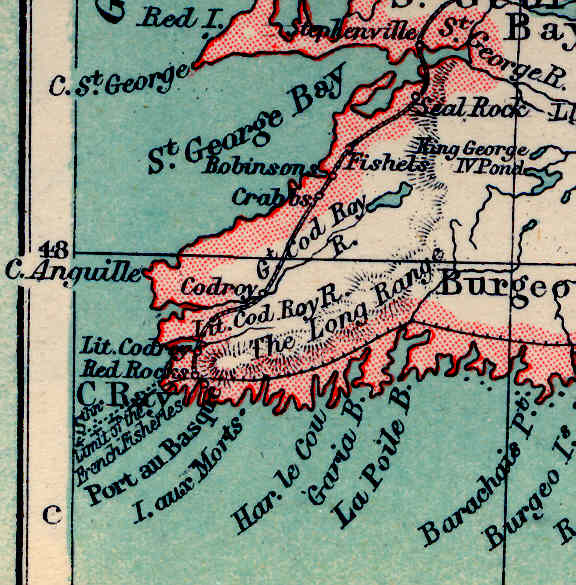
This close-up of the last few miles of the line
from Stephenville to Port-aux-Basques shows the railway line swinging
southward around mountains and rivers.
It meets the overland Newfoundland
telegraph line which Reid was also to manage - the line parallel to the
south shore.
If you look at the dotted line in the water it says "Sthn Limit
of the French Fisheries".
The French Shore ran from the dotted line
on the second map shown on this page ... counterclockwise ... to the
dotted line above.
The western railway terminus and the dashed line showing the ferry
service are neatly just outside the French Shore
zone .
As promised, Newfoundland politics lunge
A railway building history is so simple and Newfoundland politics
are so complex ...
(Reid built the railway from 1890 to 1898.)
Most of the political developments listed affected the railway.
1892
- Disastrous summer fire in St. John's leaves over 10,000 homeless,
destroying most harbourside businesses and leaving many unemployed. Besides
spending on railway construction, additional government money must be spent
for relief for the homeless.
1893
- Bond and Whiteway are re-elected as "Whiteway
Liberals".
- Bond resigns from Whiteway's new government as Whiteway's French Shore
compromises were not nationalistic enough for the younger Bond.
1894
- Seventeen Liberal
members of the House of Assembly are accused of corrupt practices (actually
... traditional practices of "using public funds to manipulate voters" ...
just a new law prohibiting this). Losing
Conservatives bring these charges against the
Liberals. Whiteway's accused members resign and the House
is prorogued indefinitely while the courts review all the charges. Newfoundland's
Governor had refused to intervene.
- The two main banks : The Commercial Bank of Newfoundland and
the Union Bank of Newfoundland fail as bank administration problems
come home to roost, and foreign investors become skittish about Newfoundland's
financial and political stability and pull their capital out. Businesses
fail, workers are thrown out of work ...
Conservatives get blamed for much of the chaos.
- New Conservative government
asks London for help to prevent Newfoundland from going bankrupt. No dice.
1895
- Reid is alarmed by the potential default on his debentures and railway
contracts if Newfoundland goes bankrupt and gets more involved in government
finances. Reid gets Canadian bank money to set up a replacement bank
... Newfoundland Government Savings Bank.
- Whiteway becomes premier again after new legislation allows "corrupt
practices" members to resume their seats.
- Newfoundland in danger of bankruptcy. Whiteway is incapacitated by the
ongoing stress. Bond goes to Ottawa to explore Confederation. Neither Canada
nor London will provide the $15 million needed.
- So ... No Confederation with Canada. No reversion to Crown Colony
status.
- Reid opens some bankers' doors for Bond in Montreal and London. Bond
obtains a short term loan from a Montreal firm to support the Newfoundland
Government Savings Bank which is now threatened. He pledges $100,000
of his own money, saves the day, and returns
to St. John's a hero .
1897
- Whiteway, Bond and Liberals
lose the election anyway - in spite of Bond's heroism.
1898
- With the railway complete and construction workers laid off, the new
Conservative government
notices that Reid's railway operating contract expires in 1903. The government
knows nothing about operating a railway and realizes that the
railway will not make money any time soon.
- Conservative finance minister
Alfred Morine and
Premier Winter negotiate with Reids to convince them to stay
on. The " 1898 Reid Contract " is passed quickly with Alfred
Morine's stewardship in the House.
- Oh ... did you know that Alfred Morine was also on retainer
from Reid to be his legal representative while Morine was Newfoundland
minister of finance and negotiating the "Reid Contract" ?
1898 Reid contract (abridged) was :
- Reid operates the line for 50 years -
then it become the property of his heirs and successors.
- Newfoundland provides additional land
grants of 5000 acres of land per mile of railway line.
- Reid returns some land grants to the
government in the future.
- Reid pays government $1 million now - helpful
to the cash-strapped government.
- Reid operates and will purchase 1000
miles of government telegraph line.
- Reid operates a coastal steamer service.
Part of Reid's contract was to relocate
the St. John's terminus (station, yard, shops) beside Whiteway's pet
project, the drydock.
With the railway shops in that location, steam locomotives could
roll in the front door of the shops for service,
and steam engines for marine propulsion could be brought in the back
door from the drydock.
The station is seen in this pre-1908 postcard view
which was mailed to Washington state.
It looks as if those "white fenceposts" are intended to keep carriages
away from the trees and grass in front of the station.
1898 Political Pandemonium cont'd
- Colonial Office in London and others think Reid Contract
terms are far too generous. Many Newfoundlanders
are scandalized.
- Morine shamed into resigning because of his conflict of interest.
- Bond is made Liberal
leader as the older, compromising Whiteway is shuffled aside, and
Bond comes at the Reid Contract like an avenging tag team
wrestler!
1900
- Reid comes back from a capital raising visit to London and asks
the Conservative government
to change his Reid Contract participant identity from a "sole
proprietorship" to the "Reid Newfoundland Company Limited". British investors
prefer this legal structure so Reid's death will not result in estate problems
which may impair the investors' interests.
- Bond, the avenging tag team wrestler, does a jump from the top
rope on this. Bond contends that revisiting the 1898 Contract opens it
up to renegotiation.
- Conservative Winter
government falls and an election ensues.
- Reid's eldest son goes against the railway's "no-politics" policy
and supports the Conservatives
in an election against Bond to protect the contract. The Reids, Newfoundland
outsiders, are now disliked in Newfoundland for trying to dispose of
Newfoundland hometown hero Bond.
- Bond Liberals win election
landslide with 90% of the seats.
1901
Bond "dictates terms" in 1901 Reid
Contract :
- Reid returns new (1898) land grants
of 1.5 million acres for $850,000.
- Reid returns the telegraph system
but Reid will be paid to operate it.
- Newfoundland will own the railway
after 50 years.
- Newfoundland returns Reid's $1 million
payment with interest.
- As in the 1898 Contract : relocate
St. John's terminal and build a new station building ; continue to operate
drydock ; continue to own and to operate the Reid-built hydro generating
station near St. John's and the Reid-built electric streetcar system in
St. John's.
With the return of much of his 1898 Contract's hard
assets to the government, Reid had to suspend many of his planned investments
in industry in Newfoundland.
Reid had tried to satisfy British investors by reshaping his personally
owned companies into a formal corporation structure. Now it would be very
difficult to find British bond investors if there were not physical assets
to seize in the event of a Reid Newfoundland Company bankruptcy and default.
Robert Reid died in 1908 at Montreal General Hospital and
the Reid Newfoundland Company was passed on to
his three sons.
Below is the Reid Newfoundland entry
from the North American "Official Guide" to the railroads of 1916.
This shows the three sons running the railway.
The R.G. Reid listed as General Superintendent is R.G. Reid, Junior.
Coincidentally in the same year that the final arrangements were
made to nationalize and consolidate a number of Canadian railways in financial
difficulty into the Canadian National Railways system - 1923 -
the Newfoundland government bought the Newfoundland railway from the Reids.
The Reids had already lost $6 million
operating the railway over their 35 years of railway operating contracts
... and it probably felt really good when that pain stopped. In 1923 the
Reids were paid $2 million
for the Newfoundland Railway and retained their various land grants
totalling 3.8 million acres
.
Reid's 'new' terminal in 1988
- Below is the terminal layout in 1988 - modified a little from
the days of the Reid Newfoundland Company.
- This photo may be sliding off the right side of your screen,
so you may want to scroll right to see everything.
- To the left, the railway runs west to Port-aux-Basques. To
the right is St. John's Harbour. This is mile 0.0
- The yard is crowded with shipping containers on flatcars,
and maintenance of way equipment.
- The boxy Reid-built station building can be see in the dead
centre of the photograph on this side of the overpass.
- Huddled under the overpass and in front of the station are retired
diesel locomotives.
- Moving to the right of the station, follow the tracks under
the overpass to the railway's shops. The shops extend from the far side of
the overpass, to the right - with Premier Whiteway's "pet idea" dry dock
area beyond that.
Who Won?
The Reid's lost money running the railway
- with high winter operating costs and low revenues from operating trains
every day through the wilderness.
Many Reid business plans for investment and development on the island
were undermined
- because the second Reid contract took away assets - against which
the Reids could have issued bonds.
Newfoundland (i.e. the taxpayers) ended up taking over a
railway which people had since come to depend on, and continued to operate
it at a loss. Taxpayers also had to try to pay off the foreign-held debentures
issued to pay for its construction.
The Politicians were sometimes able to use the railway to
get to the top of the greased pole,
but often ended up disillusioned and embittered in their retirement
- if you read beyond the narrow context of this page.
Settlements were brought closer together by dependable
transportation.
But where was economic diversification and resource development going
without the Reids ?
Perhaps the fact the no one group was a clear winner
indicates that the sometimes quaint, narrow gauge Newfoundland Railway
provided a reasonable standard of modern transportation in Newfoundland.
Maybe the railway was "just right" for Newfoundland until the highway
across the island was completed in 1965.
What beneficial effects did the railway have on Newfoundland after 1923?
What was the Newfoundland Railway's "finest hour"?
